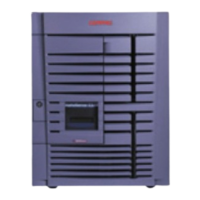System Overview 1-17
Memory Architecture
Memory throughput in this system is maximized by the following features:
•
Two independent, wide memory data buses
•
Very low memory latency (120 ns) and high bandwidth with 12 ns clock
•
ECC memory
Each data bus is 256 bits wide (32 bytes). The memory bus speed is 83 MHz.
This yields 2.6 GB/sec bandwidth per bus (32 x 83 MHz = 2.6 GB/sec). The
maximum bandwidth is 5.2 GB/sec.
The switch interconnect design takes full advantage of the capabilities of the
two wide data buses. The 256 data bits are distributed equally over two
memory motherboards (MMBs). Simultaneously, in a read operation, 128 bits
come from one MMB and the other 128 bits come from another MMB, to make
one 256-bit read. Another 256-bit read operation can occur at the same time on
the other independent data bus.
In addition, two address buses per MMB (one for each array) allow
overlapping/pipelined accesses to maximize use of each data bus. When all
arrays are identical (same size and speed), the memory is interleaved; that is,
sequential blocks of memory are distributed across all four arrays.
Memory Options
Each memory option consists of four 100 MHz, 200-pin industry-standard
DIMMs. The DIMMs are synchronous DRAMs. The Model 1 system supports
up to four memory options (16 DIMMs), and the Model 2 system supports up to
eight options (32 DIMMs). Memory options are available in the following sizes:
•
256 Mbytes (64 MB DIMMs)
•
512 Mbytes (128 MB DIMMs)
•
1 Gbyte (256 MB DIMMs)
•
2 Gbytes (512 MB DIMMs)
Memory options are installed into memory motherboards (MMBs) located on the
system motherboard (see Figure 1–7). There are four MMBs. The MMBs have
either four or eight slots for installing DIMMs.
See Chapter 6 for memory configuration.

